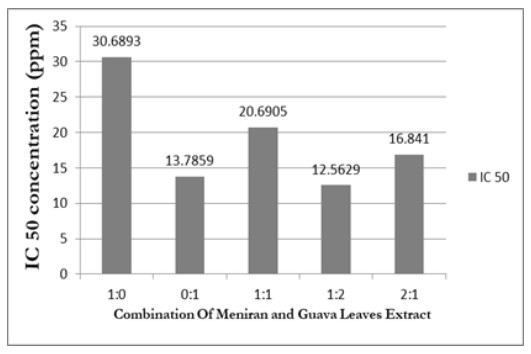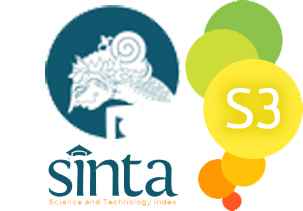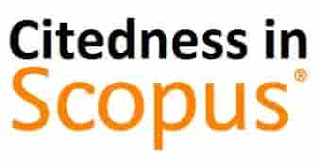The Screening of Antioxidant Activities of Meniran Plants (Phyllanthus niruri Linn) and Guava Leaves (Psidium guajava Linn) Combination Using DPPH Free Radical Method
Abstract
Degenerative disease is a serious health problem and causes a lot of deaths in Indonesia. One of the most dangerous degenerative diseases is cancer. Free radicals play a role in oxidative stress in the later stages of carcinogenesis. Antioxidant delays or inhibits cellular damage mainly through its free radical scavenging property. Meniran plants and guava leaves have high radical-scavenging activities. The previous studies reported that the combination of ginger and Meniran plant extract has a stronger antioxidant activity than the extract of a single plant. This research aims at determining the antioxidant activities of Meniran plants and guava leaves compared with its singular form. This research was conducted from October to December 2016 at the Chemical Laboratory of Nasional Health Science Institute and the Center for Development and Research of Medicinal Plants and Traditional Medicine, Tawangmangu, Karanganyar. The antioxidant activity assay was done using DPPH free radical method and vitamin C was used as the control. They were measured with UV-Vis Spectrophotometer. This study concludes that the IC50 value of Meniran plants was 30.689 ppm and the IC50 value of guava leaves was 13.7859. The IC50 values of Meniran plant and guava leaf combination with various ratios were 20.6095 ppm (1:1), 12.5629 ppm (1:2), and 16.841 ppm (2:1). The combination of Meniran plant and guava leaf extract (1: 2) had the strongest antioxidant activity of 12.56 ppm.
References
Arlofa, N. (2015). Uji kandungan senyawa fitokimia kulit durian sebagai bahan aktif pembuatan sabun. Jurnal Chemtech, 1(01). https://e-jurnal.lppmunsera.org/index.php/Chemtech/article/view/5
Arya, V., Thakur, N., Kashyap, C., & others. (2012). Preliminary phytochemical analysis of the extracts of Psidium leaves. Journal of Pharmacognosy and Phytochemistry, 1(1), 1–5. https://www.phytojournal.com/vol1Issue1/1.1.html
Bondet, V., Brand-Williams, W., & Berset, C. (1997). Kinetics and mechanisms of antioxidant activity using the DPPH Free Radical Method. Food Science And Technology-Zurich-, 30, 609–615. https://doi.org/10.1006/fstl.1997.0240
Cipak, L., Grausova, L., Miadokova, E., Novotny, L., & Rauko, P. (2006). Dual activity of triterpenoids: Apoptotic versus antidifferentiation effects. Archives of Toxicology, 80(7), 429. https://doi.org/10.1007/s00204-006-0072-6
Gibbs, R. D. (1974). Chemotaxonomy of Flowering Plants: Four Volumes. McGill-Queen’s Press-MQUP. https://www.jstor.org/stable/j.ctt1w0ddx8
Guyton, K., & Kensler, T. W. (1993). Oxidative mechanisms in carcinogenesis. British Medical Bulletin, 49(3), 523–544. https://doi.org/10.1093/oxfordjournals.bmb.a072628
Halliwell, B. (1995). How to characterize an antioxidant: An update. Biochemical Society Symposia, 61, 73–101. https://doi.org/10.1042/bss0610073
Harningsih, T., & Wimpy, W. (2018). Uji Aktivitas Antioksidan Kombinasi Ekstrak Daun Kersen (Muntingia calabura Linn.) dan Daun Sirsak (Anonna muricata Linn.) Metode DPPH (2, 2-diphenyl-1-picrilhidrazyl). Biomedika, 11(2), 70-75. https://doi.org/10.31001/biomedika.v11i2.422
Hidayati, T. (2015). Penentuan fraksi aktif ekstrak daun jambu biji (Psidium guajava) sebagai antioksidan. Thesis. IPB Respository. http://repository.ipb.ac.id/handle/123456789/75478
Kumar, A., Ilavarasan, R. Jayachandran, T., Decaraman, M., Aravindhan, P., Padmanabhan, N., Krishnan, MRV. (2009). Phytochemicals investigation on a tropical plant, Syzygium cumini from Kattuppalayam, Erode district, Tamil Nadu, South India. J. Nutr, 8(1), 83–85. http://citeseerx.ist.psu.edu/viewdoc/download?doi=10.1.1.620.2785&rep=rep1&type=pdf
Lingappa, B., & Lingappa, Y. (1967). Alkaloids as self-inhibitors of fungi. Nature, 214(5087), 516–517. https://doi.org/10.1038/214516a0
Maulana, E. A., Asih, I. A., & Arsa, M. (2016). Isolasi dan uji aktivitas antioksidan senyawa flavonoid dari ekstrak daun jambu biji putih (Psidium guajava Linn). Jurnal Kimia (Journal of Chemistry). https://doi.org/10.24843/JCHEM.2016.v10.i01.p22
Pyrzynska, K., & Pękal, A. (2013). Application of free radical diphenylpicrylhydrazyl (DPPH) to estimate the antioxidant capacity of food samples. Analytical Methods, 5(17), 4288–4295. https://doi.org/10.1039/C3AY40367J
Sasidharan, A. T. K., Balachandran, M. K., Madassery, J., Elyas, K. K., Baker, D., Chu, M., Oza, U., Rajgarhia, V., Salla, M., Fakhoury, I., & others. (2007). Enhancing health benefits of berries through phenolic antioxidant enrichment: Focus on cranberry. Asian Journal of Biotechnology, 9(2), 1225–1244. https://pubmed.ncbi.nlm.nih.gov/15927928/
Shi, H., Noguchi, N., & Niki, E. (1999). Comparative study on dynamics of antioxidative action of α-tocopheryl hydroquinone, ubiquinol, and α-tocopherol against lipid peroxidation. Free Radical Biology and Medicine, 27(3–4), 334–346. https://doi.org/10.1016/s0891-5849(99)00053-2
Singh, J. (2007). Maceration, Percolation and Infusion Techniques of Extraction of Medicinal and Aromatic Plants ( MAPs ). http://www.philadelphia.edu.jo/academics/s_telfah/uploads/method%20of%20extraction.pdf
Sumiyani, R. (2007). Perbandingan aktifitas peredaman radikal bebas 1, 1 Diphenil–2–Picryl Hydrazyl (DPPH) dari ekstrak etanol wortel lokal, wortel import, suplemen antioksidan merck ts dan merck scv. Universitas of Surabaya Repository. http://repository.ubaya.ac.id/30715/
Treare, G., & Evans, W. (1985). Pharmacognosy 17 edn. Bahive Tinal, London pp, 149.
Von Gadow, A., Joubert, E., & Hansmann, C. F. (1997). Comparison of the antioxidant activity of aspalathin with that of other plant phenols of rooibos tea (Aspalathus linearis), α-tocopherol, BHT, and BHA. Journal of Agricultural and Food Chemistry, 45(3), 632–638. https://doi.org/10.1021/jf960281n
Wulandari, P. (2011). Formula campuran ekstrak temulawak (Curcuma xanthorriza Roxb.) dan meniran (Phyllanthus niruri L.) Sebagai Antijerawat. Thesis. IPB University Repository. https://repository.ipb.ac.id/handle/123456789/52584























